The Neophyte's Custom Liquid Cooling Guide: How To, Why To, What To Expect
by Dustin Sklavos on September 30, 2013 12:01 AM ESTOf course the big reason to go through this trouble was to hopefully get an improved gaming experience out of the bargain. Slightly more stable boost clocks on the pair of GeForce GTX 780s in SLI should give them at least a leg up, and now that we're getting past the era of the shoddy console port, CPU performance is starting to become more relevant. Mutli-GPU configurations only increase CPU overhead.
Again, per the previous page:
At stock, our system ran its Intel Core i7-4770K at 3.7GHz on all four cores (3.9GHz on a single core) and the pair of GTX 780s at reference clocks.
The air overclock ran its i7-4770K at 4.3GHz on all four cores and the pair of GTX 780s with a +125 offset on the GPUs and 7.1GHz on the GDDR5.
The liquid overclock ran its i7-4770K at 4.4GHz on all four cores and the pair of GTX 780s with a +135 offset, with a stable boost at 1160MHz, and 7.1GHz on the GDDR5.
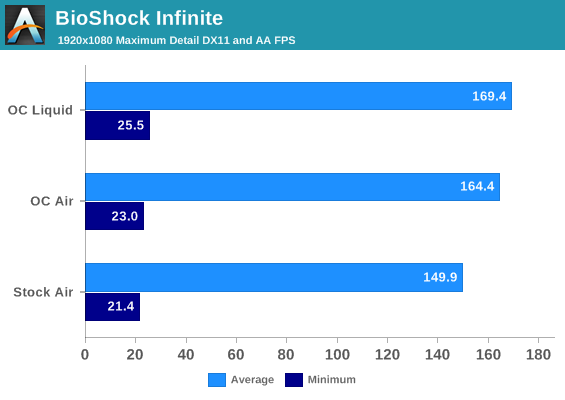
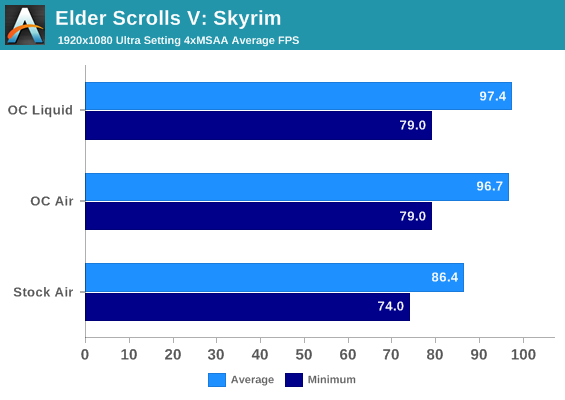
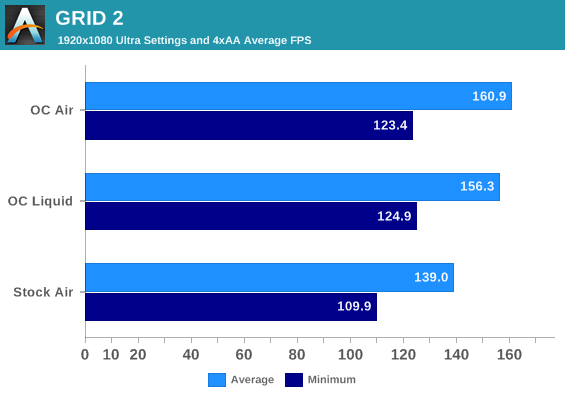
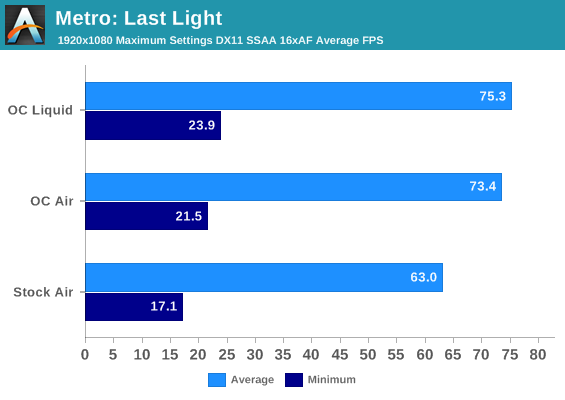
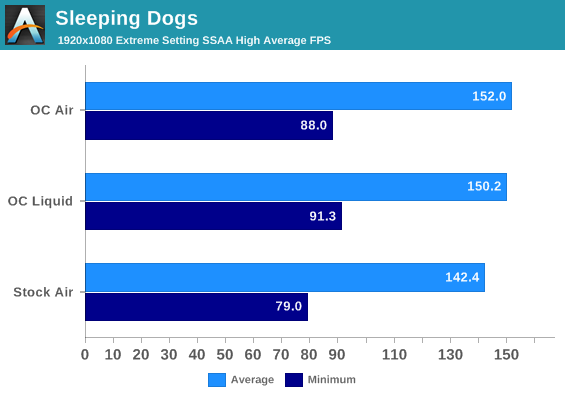
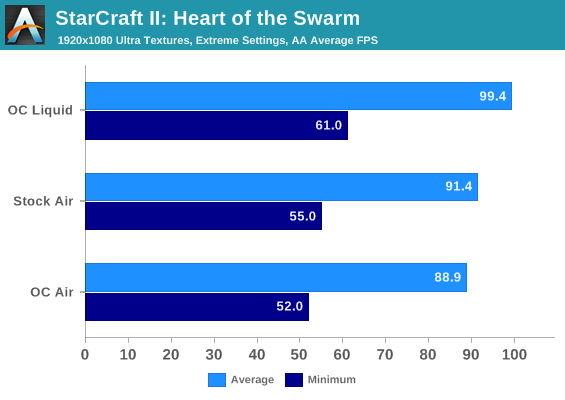
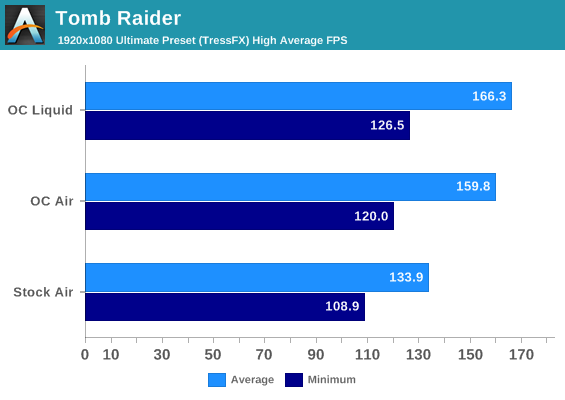
1080p tends to be more CPU limited, but let's see if there are some conclusions we can draw. I've included minimum frame rates as these are the ones we really want to boost. The initial overclock generally gives us a healthy performance jump across the board, but StarCraft II actually does worse for some reason. The modest increase in clocks going to liquid just doesn't seem to do a whole lot, but remember that the cards are spending more time at their boost clocks than they did under air. We could just be CPU limited, and the 100MHz increase on the i7-4770K may be too modest to let the cards stretch their legs.
Obviously, we need to jump to the surround resolution of 5760x1080.
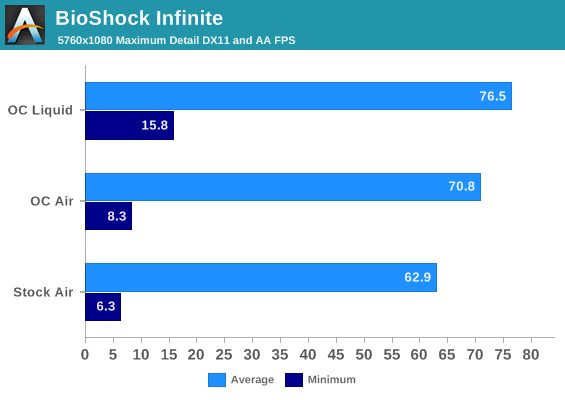
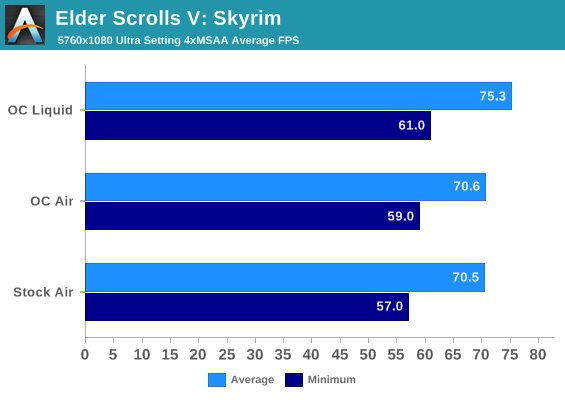


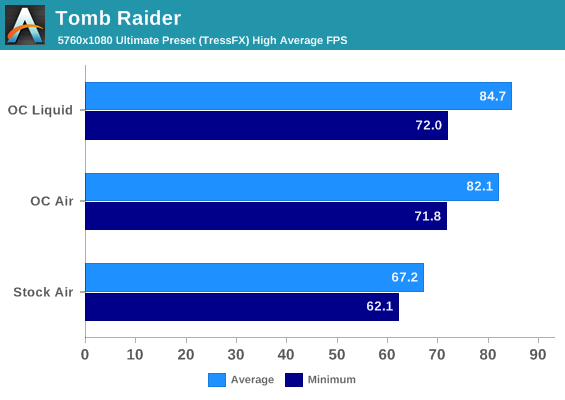
Most games continue to see only a mild increase in performance, but BioShock Infinite and Skyrim both start stretching their legs a bit more. The performance difference isn't tremendous, but it's measurable. BioShock Infinite in particular gets a really nice bump to its bottom line.










106 Comments
View All Comments
hot120 - Monday, September 30, 2013 - link
Awesome article!blanarahul - Monday, September 30, 2013 - link
Hmm.. Can you try cooling those 780s alone? Overclocking the CPU seems pointless on Haswell.valkyrie743 - Monday, September 30, 2013 - link
overclocking haswell is not pointless. just is a pain (same with ivy bridge) cause intel decided to be cheap and not solder the IHS to the cpu. if you do a mild overclock its fine give or take how bad the tim on the cpu/ihs is. but if you plan on doing high overclocks and water cooling like this. you might as well de-lid the cpu and apply your own tim. temps on air (if done right) drop a good 15 to 20C under load. I've seen people hitting 90 C and go down to 70 or less underload. and thats on air.the reason why i have no upgraded from my sandy bridge 2600K. @4.5ghz right now at 1.28 volts and my max temp running intel burn test was 70C (air)
The Von Matrices - Monday, September 30, 2013 - link
Please read my post in response to NeatOman. The result is correct but the reasoning is incorrect.gandergray - Tuesday, October 1, 2013 - link
For information about removing the cpu lid or integrated heat spreader, see the work performed by Idontcare: http://forums.anandtech.com/showthread.php?t=22618... .iTzSnypah - Monday, September 30, 2013 - link
You are cooling way too much with only 600mm worth of radiators and your deltaT is obscene. Take out 1x GTX780 and retest if possible.NeatOman - Monday, September 30, 2013 - link
I think the thermal paste between the cpu and the lid are the limiting factor here, i believe that not only will 4770K do better with better thermal paste in between the lid and cpu on just air cooling alone but also might have a larger difference between the air and water cooling.And of course there is also a full delid which i think wont be much of a threat because with water cooling you don't need the motherboard to support a large heavy cooler.
NeatOman - Monday, September 30, 2013 - link
Sorry, i meant that you wont need to put a lot of pressure like if you where supporting a large air cooler with the motherboard.The Von Matrices - Monday, September 30, 2013 - link
The issue is not the composition of the thermal paste between the die and the lid; it is the thickness of the thermal paste between the die and the lid. It's widely reported that in Ivy Bridge and Haswell there is way too much of a gap between the die and the lid due to the thickness of the glue used to secure the lid to the package. You can solve this by removing the lid, using a razor blade to remove all the glue, then put on new TIM and place the lid back on the package. No matter what new TIM you use you will get drastically reduced temperatures.Either way, Haswell runs hot due to its FIVR, and there's nothing that can be done through beefier heatsinks, delidding, or changing thermal paste that will make it cooler than an equivalently modified Ivy Bridge.
dragosmp - Monday, September 30, 2013 - link
Still, it is incomplete. The thermal transfer formula is simply Rth=rho*L/S, more thermal resistance (Rth) more the temperature delta is high between the source and ambient: deltaT=Power*RthAsuming the power is constant, to decrease deltaT you need to decrease the thermal resistance, so:
*S is the die surface, can't change that
*L is the thickness of paste - you're right, it needs to be as thin as possible; put 2x too much and you have twice the deltaT
*rho - thermal resistivity (1/lambda) - it depends on the material; Intel does use cheap paste with a conductivity around 3; were they to use fluxless solder or at least some AS5 they'd decrease the thermal resitance by a factor of 2 easily, thus offsetting a thicker than needed layer of paste.
My 2 cents: for performance the paste must be removed and replaced with something better plus as you say remove the glue to reduce the thickness. Of course one should be careful not to chip the die, but these two things really help.